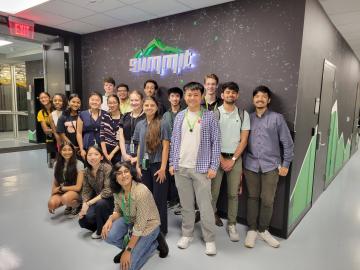
Filter News
Area of Research
- (-) Biology and Environment (178)
- (-) Fusion Energy (19)
- (-) Neutron Science (191)
- (-) Supercomputing (312)
- Advanced Manufacturing (34)
- Biological Systems (18)
- Biology and Soft Matter (5)
- Building Technologies (12)
- Chemical and Engineering Materials (4)
- Chemistry and Physics at Interfaces (11)
- Clean Energy (525)
- Climate and Environmental Systems (14)
- Computational Biology (6)
- Computational Chemistry (5)
- Computational Engineering (5)
- Computer Science (19)
- Data (1)
- Earth Sciences (1)
- Electricity and Smart Grid (3)
- Energy Frontier Research Centers (14)
- Energy Sciences (5)
- Fossil Energy (3)
- Fuel Cycle Science and Technology (3)
- Functional Materials for Energy (16)
- Fusion and Fission (55)
- Geographic Information Science and Technology (3)
- Isotope Development and Production (3)
- Isotopes (36)
- Materials (433)
- Materials Characterization (2)
- Materials for Computing (36)
- Materials Synthesis from Atoms to Systems (13)
- Materials Under Extremes (12)
- Mathematics (1)
- National Security (81)
- Neutron Data Analysis and Visualization (4)
- Nuclear Science and Technology (74)
- Nuclear Systems Modeling, Simulation and Validation (3)
- Nuclear Systems Technology (1)
- Quantum Condensed Matter (4)
- Quantum information Science (9)
- Reactor Technology (1)
- Renewable Energy (4)
- Sensors and Controls (5)
- Transportation Systems (11)
News Type
News Topics
- 3-D Printing/Advanced Manufacturing (18)
- Advanced Reactors (10)
- Artificial Intelligence (43)
- Big Data (27)
- Bioenergy (52)
- Biology (76)
- Biomedical (36)
- Biotechnology (14)
- Buildings (6)
- Chemical Sciences (15)
- Clean Water (13)
- Climate Change (52)
- Composites (5)
- Computer Science (108)
- Coronavirus (24)
- Critical Materials (4)
- Cybersecurity (9)
- Decarbonization (24)
- Energy Storage (17)
- Environment (110)
- Exascale Computing (25)
- Fossil Energy (1)
- Frontier (30)
- Fusion (16)
- Grid (7)
- High-Performance Computing (53)
- Hydropower (8)
- Isotopes (3)
- Machine Learning (21)
- Materials (37)
- Materials Science (40)
- Mathematics (4)
- Mercury (7)
- Microscopy (17)
- Molten Salt (1)
- Nanotechnology (24)
- National Security (9)
- Net Zero (3)
- Neutron Science (102)
- Nuclear Energy (18)
- Partnerships (5)
- Physics (18)
- Polymers (5)
- Quantum Computing (19)
- Quantum Science (29)
- Renewable Energy (1)
- Security (6)
- Simulation (25)
- Software (1)
- Space Exploration (5)
- Summit (46)
- Sustainable Energy (37)
- Transformational Challenge Reactor (1)
- Transportation (12)
Media Contacts

Daryl Yang is coupling his science and engineering expertise to devise new ways to measure significant changes going on in the Arctic, a region that’s warming nearly four times faster than other parts of the planet. The remote sensing technologies and modeling tools he develops and leverages for the Next-Generation Ecosystem Experiments in the Arctic project, or NGEE Arctic, help improve models of the ecosystem to better inform decision-making as the landscape changes.

The "SNS LEGO Model Middle School Outreach Program" invites middle school students to build a LEGO model of the SNS, a major scientific accelerator. This engaging initiative aims to teach students about STEM careers and the inner workings of the SNS through hands-on construction and interactive lessons. Launching next spring, the program seeks to inspire interest in science and engineering among young learners.

Nuclear physicists at the Department of Energy’s Oak Ridge National Laboratory recently used Frontier, the world’s most powerful supercomputer, to calculate the magnetic properties of calcium-48’s atomic nucleus.

John joined the MPEX project in 2019 and has served as project manager for several organizations within ORNL.

The award was given in “recognition of his lifelong leadership in fusion technology for plasma fueling systems in magnetically confined fusion systems.”

Scientists at ORNL have developed 3-D-printed collimator techniques that can be used to custom design collimators that better filter out noise during different types of neutron scattering experiments

ORNL Environmental Sciences Division Director Eric Pierce presented the division’s 2023 Distinguished Achievement Awards at the organization’s December all-hands meeting.

A team of computational scientists at ORNL has generated and released datasets of unprecedented scale that provide the ultraviolet visible spectral properties of over 10 million organic molecules.

Research performed by a team, including scientists from ORNL and Argonne National Laboratory, has resulted in a Best Paper Award at the 19th IEEE International Conference on eScience.

This summer, ORNL welcomed more than 500 students to campus through the lab’s range of internship programs, which are offered in areas such as biology, national security and computing.


